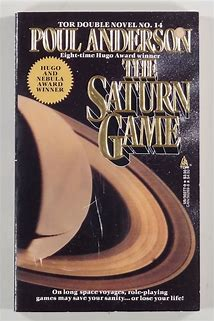Three continuing characters, Nicholas van Rijn, David Falkayn and Adzel, are distributed across seven of the eleven instalments collected in The Technic Civilization Saga, Volume I, The Van Rijn Method. However, these three characters do not co-appear in a single narrative until the second of the seven instalments collected in Volume II, David Falkayn: Star Trader. All three make their final appearances in the first of the six instalments collected in Volume III, Rise of the Terran Empire. Whether singly or together, these three characters are featured in fourteen of the twenty-four instalments collected in Volumes I-III. Of the remaining ten instalments, three are pre-Polesotechnic League whereas five are post-League. Thus, these three (of seven) volumes in themselves present a future history series, i.e., a futuristic sf series covering a period longer than the lifetimes of any individual characters.
The very first Technic History instalment, "The Saturn Game," links the late twentieth century of the author, Poul Anderson, to the fictional future of the series.
"The fact is that thresholds exist throughout reality, and that things on their far sides are altogether different from things on their hither sides. The Chronos crossed more than an abyss, it crossed a threshold of human experience.
"-Francis L. Minamoto, Death Under Saturn: A Dissenting View (Apollo University Communications, Leyburg, Luna, 2057)"
-Poul Anderson, "The Saturn Game" IN Anderson, The Van Rijn Method (Riverdale, NY, December 2009), pp. 1-73 AT I, p. 1.
One threshold is between reality and fiction. The characters in this fictional narrative cross the threshold between single-level activity and role play, then go further into the role play than anyone has done before, crossing another threshold.
A threshold with altogether different things on its hither and far sides is what the philosopher, Hegel, called the "specific quantum." Thus, a liquid becomes solid below its freezing point and gas above its boiling point. These two points are specific quanta where a quantitative increase or decrease suddenly becomes a qualitative transformation. Another example is the straw that broke the camel's back. The most significant qualitative difference is that between empirically detectable neural interactions and subjectively experienced mental states.
"The Saturn Game" links back to the mass entertainment of the twentieth century and shows a plausible, or at least possible, programme of Solar System exploration in the near future. We might imagine that this near future does not after all lead to the Technic History. However, it does contain one precursor of later developments, the Jerusalem Catholic Church. Everything connects although there is no direct connection between "The Saturn Game" and the very last Technic History instalment, "Starfog." Both stories are about the exploration of space but in different millennia and in different spiral arms of the galaxy. More thresholds have been crossed, the most important being from slower-than-light space travel to faster-than-light.

